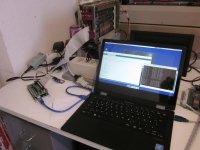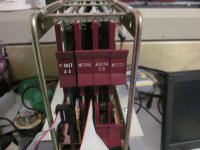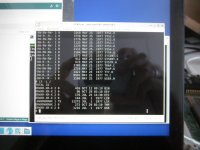medusa
Member
Hi folks,
maybe a few of you know my homepage about my PDP-11 stuff (yes I know it's terribly outdated). http://diane-neisius.de/pdp11/index_E.html
Since I still ramble around looking for DEC stuff I found this forum and information about Don's RX02 emulator. Which directly led me to his Github.
Long story short, I downloaded the Gerber files for the v4 shield and ordered some PCBs online from a German company.
Soldering parts in was not that difficult (that's why I chose the v4 - when I was young, 2.54mm was THE measure). Flashed the Arduino, did some Tests with the SDcard. And then it happened.

Plugged it into the RXV11. Hacked the bootloader in. And then - got a bootsector at location 0! It worked! Out of the box!
Some tweaking later I had a full boot of LSX. This was something I waited about 15 years for.

Here is my setup for the first debugging sessions. On the laptop, left is Arduino IDE, right is the PDP-11/03 terminal window. Meanwhile I trust the RX02 and just plug it into some Raspi PSU.

A closeup of my small H9281 backplane and the four cards residing in it. Besides the CPU there is 64k RAM (jumpered to use 60k instead of 56k, never had any I/O stuff in the range 0160000 to 0170000), the RXV11 of course and a DLV11-E console serial.

A snapshot of the terminal window. Welcome to the world of UNIX v6. "LSX" is an abbreviation of "LSI UNIX".
The first thing I did was to restore the missing 'cat' in the root disk. It is no fun to use the crappy old 'ed' editor to look into source files. This was quite easy and went exactly the way H. Lycklama (author of LSX) described in his paper about it. You can take the source from Unix v6, copy it over to the LSX disk and compile, reloc and strip it there. Presto, there is /bin/cat.
Currently I fiddle with the kernel sources. I can compile a LSX kernel from the sources but it still crashes. The vanilla kernel uses only 12kw of user space which with 8kw system is a total of only 20kw. 10kw left unused. Don't like that.
What I really find fascinating on this combination is, it was ready in about 1976. Years before Apple was founded and IBM thought about a PC. Things could have been quite different... if not Ken Olsen, Boss of DEC, had the opinion "nobody wants a computer at home". Oh well.
maybe a few of you know my homepage about my PDP-11 stuff (yes I know it's terribly outdated). http://diane-neisius.de/pdp11/index_E.html
Since I still ramble around looking for DEC stuff I found this forum and information about Don's RX02 emulator. Which directly led me to his Github.
Long story short, I downloaded the Gerber files for the v4 shield and ordered some PCBs online from a German company.
Soldering parts in was not that difficult (that's why I chose the v4 - when I was young, 2.54mm was THE measure). Flashed the Arduino, did some Tests with the SDcard. And then it happened.

Plugged it into the RXV11. Hacked the bootloader in. And then - got a bootsector at location 0! It worked! Out of the box!
Some tweaking later I had a full boot of LSX. This was something I waited about 15 years for.

Here is my setup for the first debugging sessions. On the laptop, left is Arduino IDE, right is the PDP-11/03 terminal window. Meanwhile I trust the RX02 and just plug it into some Raspi PSU.

A closeup of my small H9281 backplane and the four cards residing in it. Besides the CPU there is 64k RAM (jumpered to use 60k instead of 56k, never had any I/O stuff in the range 0160000 to 0170000), the RXV11 of course and a DLV11-E console serial.

A snapshot of the terminal window. Welcome to the world of UNIX v6. "LSX" is an abbreviation of "LSI UNIX".
The first thing I did was to restore the missing 'cat' in the root disk. It is no fun to use the crappy old 'ed' editor to look into source files. This was quite easy and went exactly the way H. Lycklama (author of LSX) described in his paper about it. You can take the source from Unix v6, copy it over to the LSX disk and compile, reloc and strip it there. Presto, there is /bin/cat.
Currently I fiddle with the kernel sources. I can compile a LSX kernel from the sources but it still crashes. The vanilla kernel uses only 12kw of user space which with 8kw system is a total of only 20kw. 10kw left unused. Don't like that.
What I really find fascinating on this combination is, it was ready in about 1976. Years before Apple was founded and IBM thought about a PC. Things could have been quite different... if not Ken Olsen, Boss of DEC, had the opinion "nobody wants a computer at home". Oh well.
